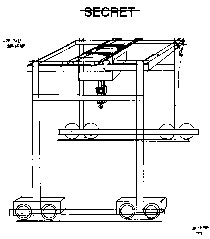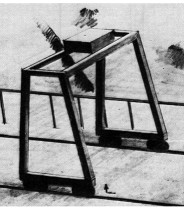

Connections Through Time, Issue 21:
October - December 2003
![]()
|
Washington -- The CIA financed a program in 1975 to develop a new kind of agent who could truly be called a "spook", Director Stanfield Turner has disclosed. The CIA chief said that the agency had found a man who could "see" what was going on anywhere in the world through his psychic powers. Turner said that CIA scientists would show the man a picture of a place and he would then describe any activity going on there at that time. The tight-lipped CIA chief wouldn't reveal how accurate the spook was, but said that the agency (ended) the project in 1975. "He died", Turner said, "and we haven't heard from him since." - Chicago Tribune, Saturday, August 13, 1977 |
 Fig. 4a Pat Price's ESP-based drawing of a gantry crane at the secret Soviet R&D site at Semipalatinsk  Fig. 4b CIA drawing based on satellite photography. Note for example, that both cranes have eight wheels. |
BACKGROUND - from the abstract:
Hundreds of remote viewing experiments were carried out at Stanford Research Institute (SRI) from 1972 to 1986. The purpose of some of these trials was to elucidate the physical and psychological properties of psi abilities, while others were conducted to provide information for our CIA sponsor about current events in far off places. We learned that the accuracy and reliability of remote viewing was not in any way affected by distance, size, or electromagnetic shielding, and we discovered that the more exciting or demanding the task, the more likely we were to be successful. Above all, we became utterly convinced of the reality of psi abilities.
One comparison between Price's predicted sketch of a crane and a CIA rendering based on satellite photography is shown at the right. This comparison was available while Price was alive.
The following is an abridged version of the excellent comparison with other feedback obtained after Price's death:
One of the most interesting things that Price saw was not in the CIA drawing, because it was inside the building that he was psychically lying on top of, and unknown to anyone in our government at the time. In this June, 1974 experiment he described a large interior room where people were working on the assembly of a giant, "sixty-foot diameter metal sphere." He said that it was being assembled from "thick metal gores," like sections of an orange peel. But, they were having trouble welding it all together, because the pieces were warping. Price said that they were looking for a lower-temperature welding material. We didn't get any feedback on this for more than three years. We discovered how accurate Price's viewings were when this sphere-fabricating activity at Semipalatinsk was eventually described in Aviation Week magazine, May 2, 1977:SOVIETS PUSH FOR BEAM WEAPON - The U.S. used high resolution photographic reconnaissance satellites to watch soviet technicians dig through solid granite formations. In a nearby building, huge extremely thick steel gores were manufactured. These steel segments were parts of a large sphere estimated to be about 18 meters (57.8 feet) in diameter. US officials believe that the spheres are needed to capture and store energy from nuclear driven explosives or pulse power generators. Initially, some US physicists believed that there was no method the Soviets could use to weld together the steel gores of the spheres to provide a vessel strong enough to withstand pressures likely to occur in a nuclear explosive fission process, especially when the steel to be welded was extremely thick.Although we were happy to receive this confirmation, unfortunately, Pat Price had already died two years earlier. So, from the point of view of the experiment, he made his perception of the sixty-foot spheres and "gores" without any feedback at all. Price's drawing of the sections of a sphere he psychically saw are shown in Figure 6. This shows that Price's remarkable perception was a direct experience of the site. He was not reading the mind of the sponsor, because no one in the United States knew of the spheres. Nor could Pat have been precognitively looking at his feedback from the future, because he received none.
The way we described this miracle to our sponsors back in Washington was as follows:
The 60-foot steel gores for the sphere construction are shown. Their existence was amazingly not discovered until three years later. Price had the size correct to within 18 inches.
Fig. 6 Sphere fabrication.
This remarkable prediction does not, in our opinion, warrant the strong conclusions highlighted in yellow above. The two sentences should, in our opinion, be clarified as follows:
1.
He was not reading the mind of the sponsor, because no one in the United States knew of the spheres at the time of the viewing. We suggest that Price might have picked up the data from the sponsor precognitively, i.e., Price could have been reading the sponsor's future knowledge concerning the ~60 foot sphere.2. Nor could Pat have been precognitively looking at his feedback from the future, because he received none. While Pat did not view his own feedback, he could have precognitively viewed the feedback from the sponsor, or he may have gathered the informatation in real-time from the conscious experiences of the people working at Semipalatinsk.
What is not clear is the meaning of "direct experience of the site". The implication is that Price somehow used his consciousness to go to the site in real-time and gather info just as if he were there. We wonder if Pat Price gathered his information from the collective experiences of others who had or who will have direct conscious interactions concerning the site.
References
Go to another section of this
issue:
Physics: Finding a Sunken Ship Lost for 150 Years Applications:
The 1973 Remote Viewing Probe of the Planet Jupiter